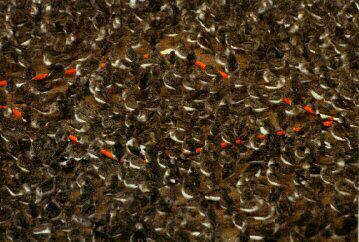
by: Kimberley Gilliland and Sherman Boates
SPRING 1992

Minas Basin and Shepody Bay in the upper Bay of Fundy have together been designated as one of only 12 Hemispheric Shorebird Reserves in the Western Hemispheric Shorebird Reserves in the Western Hemisphere. Hemispheric reserves refer to sites that are of international importance because they host 500,000 shorebirds, about 30 per cent of a flyaway population each year. The upper Bay of Fundy site is important specifically for semipalmated sandpipers. It forms a critical link between the breeding areas dispersed across the Arctic and the wintering areas in Central and South America. In July and August each year, these sparrow-sized sandpipers and other shorebirds are concentrated primarily in the Minas and Shepody Basins where they are attracted by the vast expanses of mud flats, rich in food. Twice each day, when the mud flats are uncovered by the world famous Fundy tides, sandpipers disperse across the mud flats to feed on small invertebrates, especially the mudshrimp Corophium. Fat reserves built up on these feeding stops fuel their remarkable non-stop, migration to their wintering areas 4,000 kilometers south. During the time feeding areas are covered by the tide, sandpipers congregate (roost) in tightly packed flocks on beaches and fields. At Evangeline Beach, the most important roost location in Minas Basin, flocks or 150,000 birds have been seen.
When shorebirds are in roosting flocks they are much easier to count then when they are spread across the mud flats, feeding. It can be tricky and time consuming to count the shorebirds in small roost, let alone one containing over 100,000 birds! It is important to keep track of shorebird roosts, because these counts can be used to determine how important different areas are for a particular species, and whether of not a species is increasing of declining in numbers.
Some years ago counts made by Peter Hicklin of the Canadian Wildlife Service were used to determine that between 800,000 and 1,400,000 semipalmated sandpipers fatten up in the upper Bay of Fundy each summer and fall. The area is the most important post-breeding migratory stopover for this species in the world!
Over the past two years through our studies of shorebirds and their food supply in the Evangeline Beach area, we have been able to develop an accurate and convenient method for estimating the number of small shorebirds in a roosting flock. We hope that by using this simple standardized method, we will be able to more accurately monitor changes in shorebird populations along the Bay of Fundy, as well as other areas along the coast.
You can assist us in keeping track of the migrating flocks by using the following method to monitor shorebirds in your area. To estimate the number of sandpipers in a roost you much know two things:
- the density of birds in the roost (i.e., the number of birds per metre square (m2) of roost); and
- the size of the roost (i.e., the area in metres square (m2), of the part of the beach occupied by the shorebirds).
To determine the density of birds in a roost we place a one metre square, fluorescent orange quadrant on the beach before the birds return from feeding. We make our square from plastic pipe, one metre long on each side. In this case we put the quadrant above the high tide line on Evangeline Beach. Using a 35 mm camera with a 100 mm and 300 mm telephoto lens, slides were taken of the birds inside the quadrant. The number of birds in the quadrants were then counted from the projected image.
In our example we found the average number of shorebirds in six different quadrants was 82 birds. The maximum number counted was 101 birds. It was clear from the photos that birds tended to distance themselves from the quadrant, and that 82 birds per m2 were a minimum estimate of density (i.e., a loosely packs roost), whereas 101 birds per m2 (a densely packed flock were a better estimate of the density of sandpipers in a roost.
The area of the roost is easily determined. At Evangeline Beach we identified traditional roosting sites and measured distances between landmarks (e.g., property lines, large stones, flag poles, etc.) along the shoreline. We notes on a sketch map, the edges of the roost in relation to landmarks. After the tide receded and birds moved to the feeding areas we determined the length and width of the roost by pacing off the area. The edges of the roost are often evident by the tracks and scat left be the birds.
Finally, the number of birds in the roost were then estimated by multiplying the area of the roost by 101 birds per m2 if the roost is lightly packed, or if the roost is loosely packed by 82 birds per m2. In this way, the size of the roost at Evangeline Beach on 30 July 1991 was estimates to be 131,200.
Accurate estimates of the size of shorebird roosts help us better monitor variation in the size of shorebird populations. This method is simple enough that it may be used by almost anyone. It can be a fun project for you and your family. Some innovative folks may even be able to suggest improvements to this method. If you make roost size estimates or have any suggestions, we would be glad to hear from you. Contact Sherman Boates at Wildlife Division in Kentville, 679-6091.
Acknowledgements
Special thanks to the landowners along Evangeline Beach for their patience and support during the summers of 1990 and 1991, and to Heidi Schoenfeld and Scot Gilliland for their assistance.